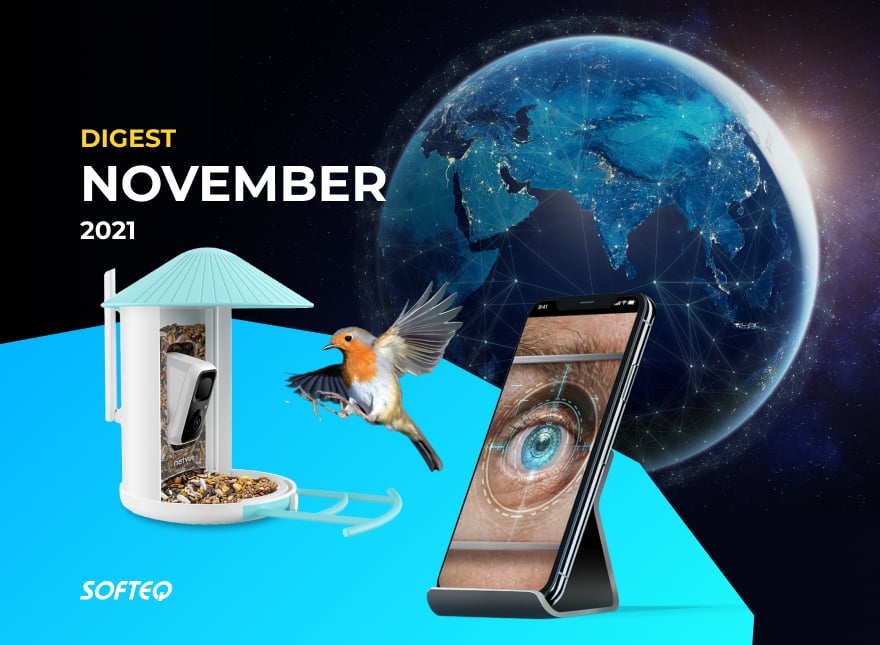Check out our latest blog article: From component to enterprise – modular robotics done right.
This is What Techies Talked About in November

In this issue of the Tech Digest: a new AI technology spots birds visiting your yard, a digital twin of Earth watches and controls climate change, and cybersecurity risks for connected medicine are still on the rise. All that and more in a 10-minute read.
Earth's Digital Twin to Track, Predict, and Navigate Climate Change
Driving value mostly in industrial contexts, digital twins have dramatically reduced the need for expensive tests and physical prototypes. But what if they could be applied to the field of climate simulation? Earth’s digital counterpart would help better understand the climate crisis. This, in turn, could help take proactive steps to mitigate its negative impact.
NVIDIA is trying to lead the field in modelling climate change. The tech giant is working to create a digital twin of the Earth. The twin will tell much about how climate change impacts people’s daily lives and how to respond to it. It will also predict changes in the atmosphere and oceans that drive the Earth's climate. The company is planning to simulate the Earth's climate 10, 20, or 30 years from now. If they succeed, we’ll be all set to take action to mitigate the risk of climate change and take measures before it's too late.
A New AI System to Recognize Wild Bird Guests
Having evolved over the past 20 years, object detection is considered a key field in AI. The technology allows computer systems to see their environments by detecting objects in photos or videos. However, detecting small moving objects is still tricky because of disturbances, illumination issues, and background interferences. One American company managed to overcome these challenges with their motion detection technology.
Netvue, security cameras manufacturer, has recently introduced a bird recognition solution Birdfy. It’s an AI-recognition bird feeder camera that spots birds when they arrive at the bird feeder and identifies their species. The solution uses a trained AI motion detection technology that captures moments of the bird’s life, visiting a feeder. It’s capable of recognizing 6,000+ bird species.
An AI-powered Accent Tool to Help People Understand and Be Understood
Accents tell people where one might be from and what their native language might be. However, accents may lead to miscommunication. It’s common to have difficulties understanding speakers with strong or foreign accents. One may speak the same language as you, but be almost incomprehensible. How can tech break this same-language challenge?
A group of three Stanford undergrads managed to create an accent translator. Using it, people could feel comfortable while communicating in their own accent. And not least importantly, others could easily understand them. The system works as follows: a neural network, trained with recordings made by professional voice actors, shifts English to and from American, Australian, British, Filipino, and Spanish accents. It converts accents directly, speech to speech. Read more about the tool that helps people communicate with each other regardless of their place of origin
A Novel AI Technology to Detect Glaucoma in 10 Seconds
Diagnosing glaucoma typically involves a 30-minute test with an ophthalmologist or a visit to a specialized clinic. However, not everyone has access to such specialists. A team of engineers and ophthalmologists from Australia found an easier way to diagnose the disease. It's supposed to help millions of people who are at risk of developing glaucoma.
It is an AI-powered solution capable of making images of people’s eyes at 60 frames per second as they focus on a point under ambient light conditions. Then, a machine learning algorithm detects minute changes in a person's pupil response to light. Learn more about this non-contact, easy-to-use and low-cost test that can be performed at any clinic.
Seven Key Trends To Shape Digital Transformation in 2022
2022 is coming and bringing new technological advancements. To accelerate their digital transformation, companies must stay ahead of ever-changing digital trends. The latest research from MuleSoft identifies seven top digital transformation trends for 2022.
For example, businesses will have to adapt to work built on connected experiences. It becomes possible with collaboration platforms. Also, enterprises are recommended to imply hyper-automation at the strategic level. Organizations can rapidly automate their processes with low‑code platforms or machine learning. This will result in improved productivity and operational efficiency. Read on to learn the five remaining trends and how to use them.
